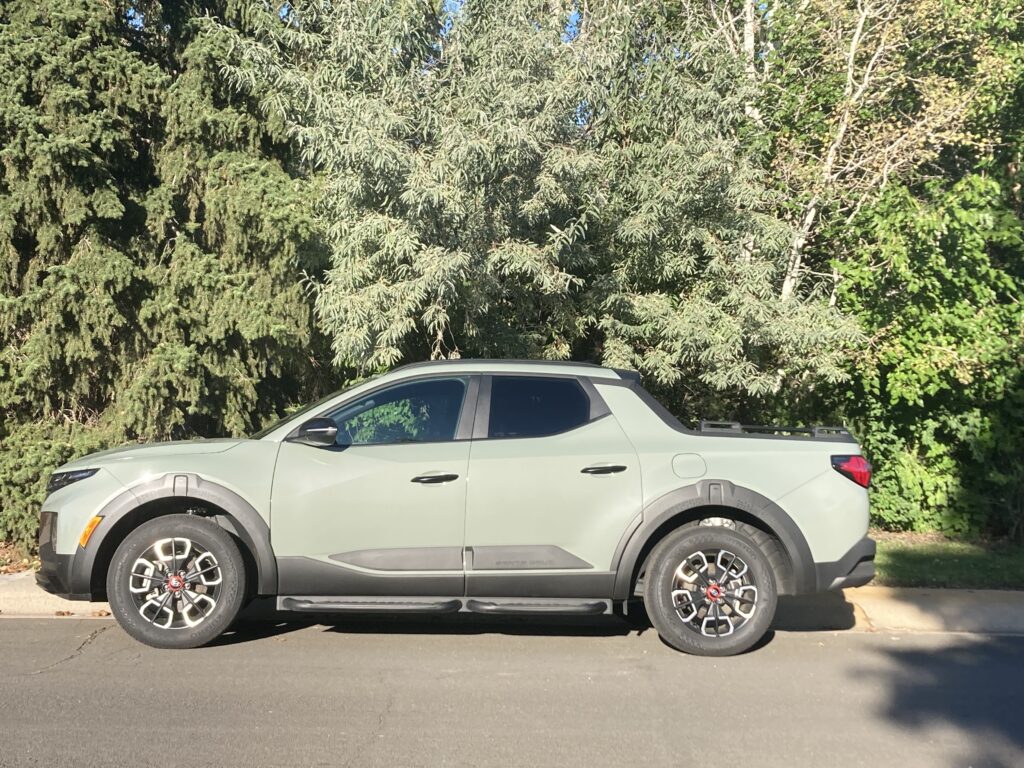
Beginning its third year of production, the 2024 Hyundai Santa Cruz minipickup showed up at my home in a more rugged-looking new trim – the XRT.
Already known for departure from the norm in pickup appearance, the Santa Cruz’s new edition adds distinctive fender flares, side steps, bed rails, orange center caps on the wheels, black mirror caps and black door handles.
Its exterior style may be unordinary, but the finish was one of the most beautiful light-green hues I’ve seen; actually, according to Hyundai, its color is “sage gray.”
The 281-horsepower, turbocharged 2.5-liter, 4-cylinder engine and 8-speed, dual-clutch automatic transmission, previously optional, are now standard on the XRT. Standard also is all-wheel drive.
Jan and I drove it north to Cheyenne for a Sunday evening dinner (Rib & Chop House). The Santa Cruz drives, rides and handles very carlike; it is based on the Hyundai Tucson’s unibody platform. Midrange power is very adequate for the S-Cruz after relatively slow takeoffs and the overall drive is fun with dual-clutch quick shifts, even quicker with use of the paddle shifters.
Rear-side vision from the driver seat is impaired, blocked by the front-seat headrests and the pickup’s undersized rear-side windows. Side-by-side small-circle speedometer and tachometer in the instrument panel appear to be a throwback to olden days; that impression is dispelled when the engagement of a turn signal flashes a view of the left or right side of the vehicle in the circles, a modern marvel.
The easy, 144-mile drive, there and back on U.S. 85 in order to avoid heavy traffic on I-25, resulted in a high fuel mileage reading of 27.6. EPA estimate for the Santa Cruz XRT is 19/27/22.
Sticker price on the XRT review model is $41,635. The Santa Cruz Limited is the only trim higher-priced than the XRT. Base model begins around $29,000.
The side steps provided Jan with easy entry. Inside, the seats look of leather, though they are of leatherette/polyvinyl. Legroom is somewhat limited in the rear seating area. The seats are flip-ups, with storage bins.
The integrated tonneau-covered box at back is of limited size, measuring 52.1 inches long and 57.9 wide, 42.7 between wheel wells. Built-in steps in bumper corners assist access. Drop the tailgate to access a small, lockable storage space beneath the bed floor. A self-leveling rear suspension helps a tow capacity, which is rated at up to 5,000 pounds.
A close competitor to the Santa Cruz is the three-year-old Ford Maverick, also of unibody construction, 4 inches longer than the overall length of the Hyundai, and a small bed a bit longer than the Santa Cruz bed.
The Hyundai is 195.7 inches in overall length on a wheelbase of 118.8 inches. Its curb weight is 4,200 pounds.
Another unibody competitor is the Honda Ridgeline, though the Santa Cruz is smaller. The Honda is 6 ½ inches longer in wheelbase, 14 inches in overall length and is 300 pounds heavier in curb weight.